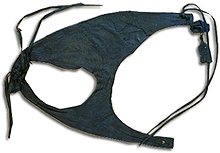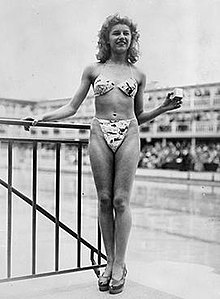Bikini: Difference between revisions
Undid revision 337533936 by 174.1.36.54 (talk) |
come on! |
||
| Line 4: | Line 4: | ||
The '''bikini''' or '''two piece''' is a women's [[swimsuit]] with two parts, one covering the [[breast]]s, the other the [[groin]] (and optionally the [[buttocks]]), leaving an uncovered area between the two (optionally in the case of the [[Tankini]]). It is often worn in hot weather or while [[human swimming|swimming]]. The shapes of both parts of a bikini resemble women's underwear, and the lower part can range from revealing [[thong (clothing)|thong]] or [[g-string]] to briefs and modest square-cut [[shorts]]. ''[[Webster's Dictionary#Merriam–Webster's Collegiate Dictionary|Merriam–Webster's Collegiate Dictionary]]'' (11th edition) describes the bikini as "a woman's scanty two-piece bathing suit", "a man's brief swimsuit" and "a man's or woman's low-cut briefs". |
The '''bikini''' or '''two piece''' is a women's [[swimsuit]] with two parts, one covering the [[breast]]s, the other the [[groin]] (and optionally the [[buttocks]]), leaving an uncovered area between the two (optionally in the case of the [[Tankini]]). It is often worn in hot weather or while [[human swimming|swimming]]. The shapes of both parts of a bikini resemble women's underwear, and the lower part can range from revealing [[thong (clothing)|thong]] or [[g-string]] to briefs and modest square-cut [[shorts]]. ''[[Webster's Dictionary#Merriam–Webster's Collegiate Dictionary|Merriam–Webster's Collegiate Dictionary]]'' (11th edition) describes the bikini as "a woman's scanty two-piece bathing suit", "a man's brief swimsuit" and "a man's or woman's low-cut briefs". |
||
Predecessors of the bikini, which shocked when it appeared on French beaches in 1947, dates back to [[Ancient history|antiquity]], in [[Çatalhöyük]]<ref name=Agrawala/> and the [[Greco-Roman world]].<ref>Peter J. James, I. J. Thorpe & Nick Thorpe, ''Ancient Inventions'', page 279, Ballantine Books, 1994, ISBN 0345401026</ref> The modern bikini was invented by French engineer [[Louis Réard]] in 1946. He named it after [[Bikini Atoll]] in the Pacific, the site of the [[Operation Crossroads]] nuclear weapon tests in July that year. The reasoning was that the burst of excitement created by it would be like a [[nuclear device]]. The [[monokini]], a bikini variant, is a [[back formation]] from ''bikini'', interpreting the first syllable as the [[Latin]] prefix ''[[wikt:bi-|bi-]]'' meaning "two" or "doubled", and substituting for it ''[[wikt:mono-|mono-]]'' meaning "one".<ref>Bill Sherk, ''500 Years of New Words'', page 284, Dundurn Press Ltd., 2004, ISBN 1550025252</ref> [[Jacques Heim]] called his bikini precursor the ''Atome'', named for its size, and Louis Réard claimed to have "split the ''Atome''" to make it smaller. |
|||
From a 1949 [[Los Angeles Times]] report: "The bathing beauty queen—blond [[BeBe Shopp|Bebe Shopp]], 18, of Hopkins, Minn.—got an enthusiastic welcome in Paris, but she said she hasn't changed her mind about French swim suits. ... 'I don't approve of Bikini suits for American girls,' Bebe told her French interviewers. 'The French girls can wear them if they want to, but I still don't approve of them on American girls."<ref>"Miss America Stops in Paris—Traffic, Too." ''Los Angeles Times''. August 7, 1949. p. 1</ref> |
From a 1949 [[Los Angeles Times]] report: "The bathing beauty queen—blond [[BeBe Shopp|Bebe Shopp]], 18, of Hopkins, Minn.—got an enthusiastic welcome in Paris, but she said she hasn't changed her mind about French swim suits. ... 'I don't approve of Bikini suits for American girls,' Bebe told her French interviewers. 'The French girls can wear them if they want to, but I still don't approve of them on American girls."<ref>"Miss America Stops in Paris—Traffic, Too." ''Los Angeles Times''. August 7, 1949. p. 1</ref> |
||
Revision as of 19:29, 15 January 2010

The bikini or two piece is a women's swimsuit with two parts, one covering the breasts, the other the groin (and optionally the buttocks), leaving an uncovered area between the two (optionally in the case of the Tankini). It is often worn in hot weather or while swimming. The shapes of both parts of a bikini resemble women's underwear, and the lower part can range from revealing thong or g-string to briefs and modest square-cut shorts. Merriam–Webster's Collegiate Dictionary (11th edition) describes the bikini as "a woman's scanty two-piece bathing suit", "a man's brief swimsuit" and "a man's or woman's low-cut briefs".
Predecessors of the bikini, which shocked when it appeared on French beaches in 1947, dates back to antiquity, in Çatalhöyük[1] and the Greco-Roman world.[2] The modern bikini was invented by French engineer Louis Réard in 1946. He named it after Bikini Atoll in the Pacific, the site of the Operation Crossroads nuclear weapon tests in July that year. The reasoning was that the burst of excitement created by it would be like a nuclear device. The monokini, a bikini variant, is a back formation from bikini, interpreting the first syllable as the Latin prefix bi- meaning "two" or "doubled", and substituting for it mono- meaning "one".[3] Jacques Heim called his bikini precursor the Atome, named for its size, and Louis Réard claimed to have "split the Atome" to make it smaller.
From a 1949 Los Angeles Times report: "The bathing beauty queen—blond Bebe Shopp, 18, of Hopkins, Minn.—got an enthusiastic welcome in Paris, but she said she hasn't changed her mind about French swim suits. ... 'I don't approve of Bikini suits for American girls,' Bebe told her French interviewers. 'The French girls can wear them if they want to, but I still don't approve of them on American girls."[4]
The bikini is perhaps the most popular female beachwear around the globe, according to French fashion historian Olivier Saillard due to "the power of women, and not the power of fashion". As he explains, "The emancipation of swimwear has always been linked to the emancipation of women."[5] By the mid 2000s bikinis had become a US$811 million business annually, according to the NPD Group, a consumer and retail information company.[6] The bikini has boosted spin-off services like bikini waxing and the sun tanning industries.[7]
History



The history of the bikini is a checkered one. The earliest evidence of a bikini-like costume dates back to the Chalcolithic era, as the mother-goddess of Çatalhöyük, a large ancient settlement in southern Anatolia, is depicted astride two leopards wearing garb akin to a modern bikini.[1] Two-piece garments worn by women for athletic purposes are on Greek urns and paintings dating back to 1400 BC.[8] Active women of ancient Greece wore a breastband called a mastodeton or an apodesmos, which continued to be used as an undergarment in the Middle Ages.[9] While men in ancient Greece abandoned the perizoma, partly high-cut briefs and partly loincloth, women performers and acrobats continued to wear it.[10] Artwork dating back to the Diocletian period (286-305 AD) in Villa Romana del Casale, Sicily depicts women in garments resembling bikinis in mosaics on the floor.[5][11] The images of ten women, dubbed the "Bikini Girls",[12] exercising in clothing that would pass as bikinis today, are the most replicated mosaic among the 37 million colored tiles at the site.[13] Archeological finds, especially in Pompeii, show the Roman goddess Venus wearing a bikini. A statue of Venus in a bikini was found in cupboard in the southwest corner in Casa della Venere, others were found in the front hall.[14] A statue of Venus was recovered from the tablinum of the house of Julia Felix,[15] and another from an atrium at the garden at Via Dell'Abbondanza.[16]
The modern bikini started to emerge again in 1907, when Australian swimmer and performer Annette Kellerman was arrested on a Boston beach for wearing a form-fitting one-piece which became an accepted swimsuit for women by 1910. Pictures of her were produced as evidence in the Esquire magazine versus United States Postmaster General legal battle over indecency in 1943. In 1913, inspired by the introduction of females into Olympic swimming, the designer Carl Jantzen made the first functional two-piece swimwear, a close-fitting one-piece with shorts on the bottom and short sleeves on top.[17] By the 1930s, necklines plunged at the back, sleeves disappeared and sides were cut away. Hollywood endorsed the new glamour with films such as Neptune's Daughter in which Esther Williams wore provocatively named costumes such as "Double Entendre" and "Honey Child".[18] With new materials like lastex and nylon, by 1934 the swimsuit started hugging the body and had shoulder straps to lower for tanning.[19] Burlesque and vaudeville performers wore two-piece outfits in the 1920s, and in 1932 French designer Madeleine Vionnet offered an exposed midriff in an evening gown.[20]
By the early 1940s two-piece swimsuits were frequent on American beaches. Hollywood stars like Ava Gardner, Rita Hayworth and Lana Turner tried similar swimwear or beachwear.[21] Pin ups of Hayworth and Esther Williams in the costume were widely distributed.[17] Finally, the modern bikini was introduced by French engineer Louis Réard and fashion designer Jacques Heim in Paris in 1946. Réard was a car engineer but by 1946 he was running his mother's lingerie boutique near Les Folies Bergères in Paris.[22] Heim was working on a new kind of beach costume. It comprised two pieces, the bottom large enough to cover its wearer's navel. In May 1946, he advertised it as the world's "smallest bathing suit". Réard named his swimsuit the “bikini,” taking the name from the Bikini Atoll, one of a series of islands in the South Pacific where testing on the new atomic bomb was occurring that summer. Historians assume Reard termed his swimsuit the “bikini” because he believed its revealing style would create reactions among people similar to those created by America’s atomic bomb in Japan just one summer earlier.[1] Réard sliced the top off the bottoms and advertised it as "smaller than the smallest swimsuit".[23][24] Réard could not find a model to wear his design. He ended up hiring Micheline Bernardini, a nude dancer from the Casino de Paris.[25] That bikini, a string bikini with a g-string back of 30 square inches (194 cm2) of clothes with newspaper type printed across, was introduced on July 5 at Piscine Molitor, a public pool in Paris.[17][26] Heim's design was the first worn on the beach, but clothing was given its name by Réard.[5]
Bikini variants


The bikini has spawned many stylistic variations. A regular bikini is defined as a two pieces of garments that cover the groin and buttocks at the lower end and the breasts in the upper end. Some bikinis can offer a large amount of coverage, while other bikinis provide only the barest minimum. Topless variants may still be considered bikinis, although technically no longer two-piece swimsuits. [27][28] Along with a variation in designs, the term bikini was followed by an often hilarious lexicon including the monokini (top part missing), seekini (transparent bikini), tankini (tank top, bikini bottom), camikini (camisole top and bikini bottom) and hikini.[29] Since fashions of different centuries exist beside one another in early 21st century, though it is possible to imagine a woman combining a bikini and a 1910 bathing costume.[30]
Bikini tops come in several different styles and cuts, including a halter-style neck that offers more coverage and support, a strapless bandeau, a rectangular strip of fabric covering the breasts that minimizes large breasts, a top with cups similar to a push-up bra, and the more traditional triangle cups that lift and shape the breasts. Bikini bottoms vary in style and cut and in the amount of coverage they offer, coverage ranging anywhere from complete underwear-style coverage, as in the case of more modest bottom pieces like briefs, shorts, or briefs with a small skirt-panel attached, to almost full exposure, as in the case of the thong bikini. Skimpier styles have narrow sides, including V-cut (in front), French cut (with high-cut sides) and low-cut string (with string sides).[27][28] In just one major fashion show in 1985 were two-piece suits with cropped tank tops instead of the usual skimpy bandeaux, suits that are bikinis in front and one-piece in back, suspender straps, ruffles, and daring, navel-baring cutouts.[31] Subsequent variations on the theme include the monokini, tankini, string bikini, thong, slingshot, minimini, teardrop, and micro.[32]
Bikini underwear
Types of underwear worn by both men and women are identified as bikini underwear, similar in size and revealing nature to the bottom half of a bikini bathing suit. For women, bikini underwear can refer to virtually any tight, skimpy, or revealing undergarment that provides less coverage to the midsection than traditional underwear, panties or knickers. For men, a bikini is a type of undergarment that is smaller and more revealing than men's briefs.
Sports bikini


There is evidence of ancient roman women playing Expulsim Ludere, an early version of handball.[33] Female athletes who play beach volleyball professionally usually wear two-pieces. These bikinis are designed with functionality rather than fashion in mind.
Beach volleyball
In 1994, the bikini became the official uniform of women's Olympic beach volleyball, marking a female sexuality that was also athletic. It also sold tickets.[6] Dancers, sex appeal and bikinis worn by women players as much as athletic ability made beach volleyball the fifth largest television audience of all the sports at the Games at Bondi Beach in Australia in 2000 Olympics.[34] The popularity of Dead or Alive: Xtreme Beach Volleyball, a video game for Xbox, was attributed to the scantily clad women.[35]
Athletics
Often the women in athletics also wear bikinis, not much larger than in beach volleyball. Amy Acuff, an US high-jumper, wore a black leather bikini instead of a track suit, at Sydney 2000 Summer Olympics.[36] Speedster Florence Griffith-Joyner mixed bikini bottoms with one-legged tights in Seoul 1988 Summer Olympics, which earned her more attention than her record breaking in Women's 200 meters.[37] Towns like Porto Seguro in Brazil has become an attraction for beach athletics in bikini for the tourists.[38]
Controversy
Skimpy bikinis have been a major component of marketing woman's sports, raising some objections.[39] In 2007, fans voted for contestants in the WWE Diva contest after watching them playing beach volleyball in skimpy bikinis.[40] In the 2004 and 2008 Olympic Games, inclusion of bikini-clad athletes raised eyebrows, while a controversy broke out around bikini-clad cheerleaders performing at a beach volleyball match.[41][42] Bikinis stirred up a controversy at the 2006 Asian Games at Doha, Qatar, and the Iraqi teams refused to wear such clothing.[43] In the 2007 South Pacific Games, players were made to wear shorts and cropped sports tops instead of bikinis.[44] In the West Asian Games 2006, bikini-bottoms were banned for female athletes, who were asked to wear long shorts.[45] String bikinis and other skimpy clothes are also common in surfing, paving the way for some hooliganism in the past.[46]
Men's bikini


The term men's bikini is used to describe types of men's swimsuits, men's underwear, or similar garments. Men's bikinis can have both high or low side panels, string sides or tie sides, and most lack a button or flap front. Many do not have a visible waistband like briefs. Suits less than 1.5 inches wide at the hips are less common for sporting purposes and are most often worn for recreation, fashion, and sun tanning. An example of this style, known as the posing brief, is the standard for competitions in the sport of bodybuilding. Male punk rock musicians have performed on the stage wearing women's bikini briefs.[47] The 2000 Bollywood film Hera Pheri shows men sunbathing in bikinis, who were mistakenly believed to be girls from a distance by the protagonist.[48]
Swimsuits shown in men's wear collections by Giorgio Armani, Dolce & Gabbana or Paul Smith have tended to be black and snug fitting, throwbacks to the designs of the 1930s and '40s, while Gianni Versace's ads with their heroic depictions of Miami bathers in contrast to popular, sports-inspired beach wear—bright and baggy Bermudas or boxer shorts. The Greek designer Nikos Apostolopoulos put a different spin on his bathing suits (for both sexes, but with the focus on the male), making them anatomical creations, cut and stitched to outline the body and its sexual characteristics.[49]
Traditionally in the past, general society did not accept men wearing bikinis at public beaches or swimming pools. However, as with the women's liberty movement, it is becoming more accepted for men to wear more revealing swimsuits at public locations.[citation needed] Men can now be seen wearing bikinis, thongs, and g-strings at pools and beaches throughout the world; however, it is still less popular in the United States than in Europe where men have been wearing bikinis for decades.[citation needed] Bikini tops for men are seen as an amusement factor.[50]
Mankini
Mankini is a type of sling bikini worn by men. It was popularized by Sacha Baron Cohen when he donned one in the film Borat. The buzz around the film started building during the Cannes Film Festival in May 2006, when Baron Cohen posed in character on the beach in a neon green mankini, alongside four models.[51] According to one fashion expert, suspenders combined with bikini briefs or panties form an unaesthetic pattern.[52] According to another, the Borat connection with the style has made it a bit humorous.[53]
See also
References
- ^ a b Prithvi Kumar Agrawala, Goddessess in Ancient India, page 12, Abhinav Publications, 1984, ISBN 0391029606
- ^ Peter J. James, I. J. Thorpe & Nick Thorpe, Ancient Inventions, page 279, Ballantine Books, 1994, ISBN 0345401026
- ^ Bill Sherk, 500 Years of New Words, page 284, Dundurn Press Ltd., 2004, ISBN 1550025252
- ^ "Miss America Stops in Paris—Traffic, Too." Los Angeles Times. August 7, 1949. p. 1
- ^ a b c Kathryn Westcott, "The Bikini: Not a brief affair", BBC News, 2006-06-05
- ^ a b Sylvia Rubin, "Fashion shocker of '46: the naked belly button", San Francisco Chronicle, 2006-07-02
- ^ Lorna Edwards, "You've still got it, babe, The Age, 2006-06-03
- ^ Cornwell, Rupert (2006-06-17). "Boom and Bust: The nuclear age and the bikini age". The Independent. Retrieved 2008-09-30.
{{cite news}}: Italic or bold markup not allowed in:|publisher=(help); Unknown parameter|coauthors=ignored (|author=suggested) (help) - ^ Stephanie Pedersen, Bra, page 8, David & Charles, 2004, ISBN 071532067X
- ^ Larissa Bonfante, Etruscan Dress, page 21, JHU Press, 2003, ISBN 0801874130
- ^ Villa Romana del Casale, Val di Noto
- ^ Allen Guttmann, Women's Sports: A History, page 38, Columbia University Press, 1991, ISBN 023106957X
- ^ Villa Romana del Casale, World Heritage Sites
- ^ Pompeian Households, Stoa Image Gallery, The Stoa Consortium
- ^ Mary Beard & John Henderson, Classical Art, page 116, Oxford University Press, 2001, ISBN 0192842374
- ^ Elisabeth B. MacDougall, Wilhelmina Mary Feemster Jashemski & Dumbarton Oaks, Ancient Roman Gardens, page 38, Dumbarton Oaks, 1979, ISBN 0884021009
- ^ a b c Hoover, Elizabeth D. (2006-07-05). "60 Years of Bikinis". American Heritage Inc. Retrieved 2007-11-13.
- ^ David Sandhu, "Nottingham: Bathed in nostalgia", The Telegraph (UK), 2003-08-04
- ^ History of the Bikini, Carnival
- ^ Samantha Critchell, "Little wonder that bikinis have fit in almost from the start", The San Diego Union-Tribune, 2006-05-28
- ^ James Kitchling, Short History of Bikinis and Swimsuits, 3X24 News Magazine
- ^ Adam Sage, "Happy birthday: the 'shocking and immoral' bikini hits 60", The Times, 2006-04-16
- ^ Paula Cocozza, "A little piece of history", The Guardian, 2006-06-10
- ^ The Bikini Turns 60, 1946 to 2006: 60 Years of Bikini Bathing Beauties, Lilith E-Zine
- ^ Rosebush, Judson. "Michele Bernadini: The First Bikini". Bikini Science. Retrieved 2007-09-19.
- ^ Bikini Introduced, This Day in History, History Channel
- ^ a b What is a Bikini?, WiseGeek
- ^ a b Bikini, Swimsuit Styles
- ^ Barry J. Blake, Playing with Words: Humour in the English Language, page 59, Equinox, 2007, ISBN 1845533305
- ^ Jacques Laurent & Cécil Saint-Laurent, A History of Ladies Underwear, page 214, Joseph, 1968, ISBN 0718106245
- ^ Fashion Correspondent, "Swimsuits take some inspiration from the past", Philadelphia Inquirer, 1985-11-10
- ^ David Diefendorf & James Randi, Amazing... But False!: Hundreds of "Facts" You Thought Were True, But Aren't, page 33, Sterling, 2007, ISBN 1402737912
- ^ John Anthony Cuddon, The Macmillan Dictionary of Sports and Games, page 393, Macmillan, 1980, ISBN 0333191633
- ^ Stuff Writer, "Beach volleyball a popular spectator sport", ESPN, 2004-08-16
- ^ Charles Harold, GAME THEORY; It's Hot-Potato Season: Call In the String Bikinis, New York Times, 2003-08-07; Retrieved: 2008-03-12
- ^ Staff Correspondent, "Hype Hopes Today's Olympians need more than athletic prowess to win gold", Fort Worth Star-Telegram, 2000-08-06
- ^ Anne Marie Balsamo, Technologies of the gendered body, page 46, Duke University Press, 1996, ISBN 0822316986
- ^ James Brooke, "In the Land of Lambada", 1991-03-10
- ^ Laura Grae Kilborn, "The Marketing Of Female Athletes", Denver Post, 1998-08-11
- ^ WWE Diva Search, Propeller News, 2007-09-18; Retrieved: 2008-03-12
- ^ Phil Gordos, Bikini girls making waves, BBC, 2004-08-25; Retrieved: 2008-03-12
- ^ Associated Press, Beach volleyball’s bikini cheerleaders stir up a storm, NBC sports, 2004-08-17; Retrieved: 2008-03-12
- ^ Associated Press, In Doha, beach volleyball bikinis create cultural clash, Ynet News, 2006-03-12; Retrieved: 2008-03-12
- ^ Staff Correspondent, No bikinis for beach volleyball players, The News, 2007-08-31; Retrieved: 2008-03-12
- ^ Staff Correspondent, "Unveiling the spirit of the sporting women", The Economic Times, 2006-12-01
- ^ Matt Krantz, "Sponsors get gnarly idea: Surf sells, dude", USA Today, 2001-08-06
- ^ A. W. Richard Sipe, A Secret World, page 25, Psychology Press, 1990, ISBN 0876305850
- ^ Ruth Vanita, Queering India, page 207, Routledge, 2002, ISBN 0415929504
- ^ Suzy Menkes, "Runways: Remembrance of Thongs Past", The New York Times, 1993-07-18
- ^ Sarah Karnasiewicz, Here she comes, "Mr. Saugus High School", Salon.com
- ^ Josh Friedman & Lorenza Munoz, "Fox scales back `Borat' movie's opening; The comedy will first be shown in 800 theaters, down from 2,000, amid a lack of awareness", The Los Angeles Times, page C1, 2006-10-25
- ^ Joan Nunn, Fashion in Costume, 1200-1980: 1200-1980, page 222, Herbert Press, 1984, ISBN 0906969379
- ^ Sling bikini, Brazilian Bikinis
External links
- Evolution on the swimwear on Fashion Era
- Bikini in beauty contests
- Bikini Science: A comprehensive site on the bikini
- Bikini exhibition
